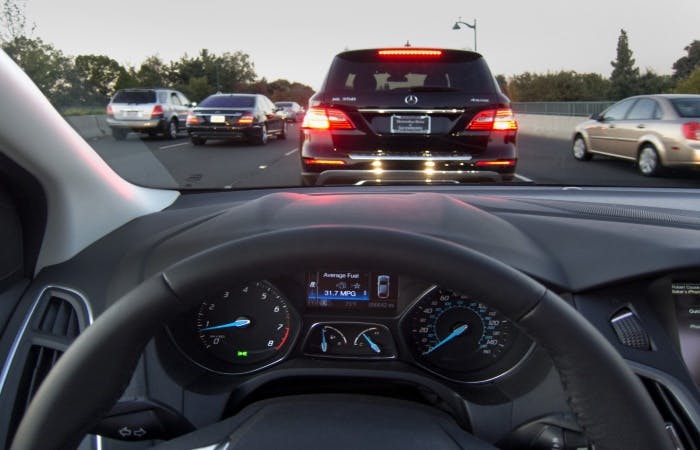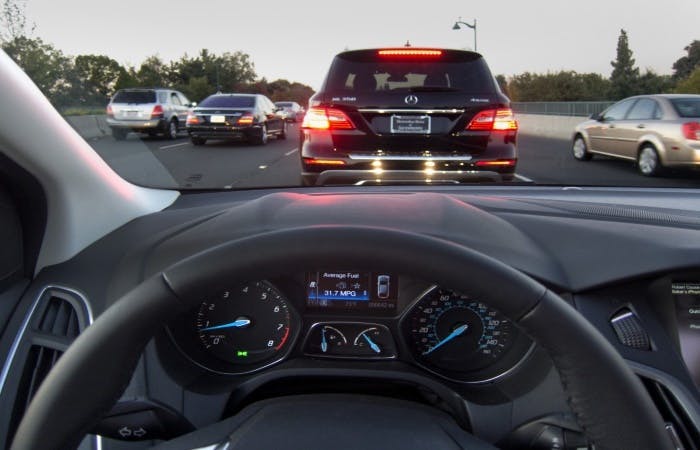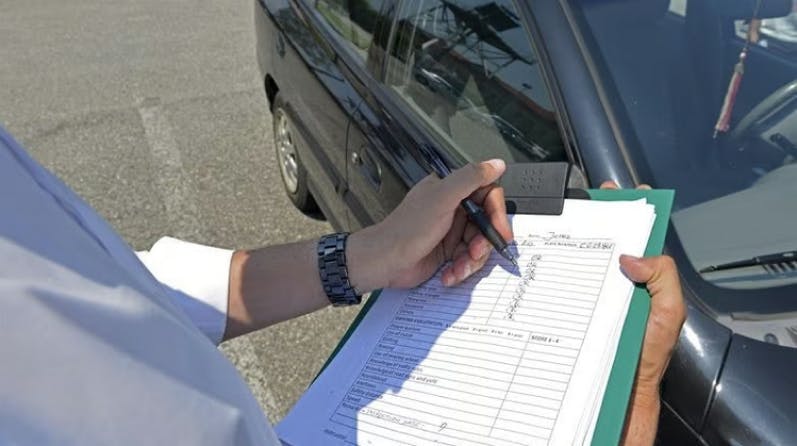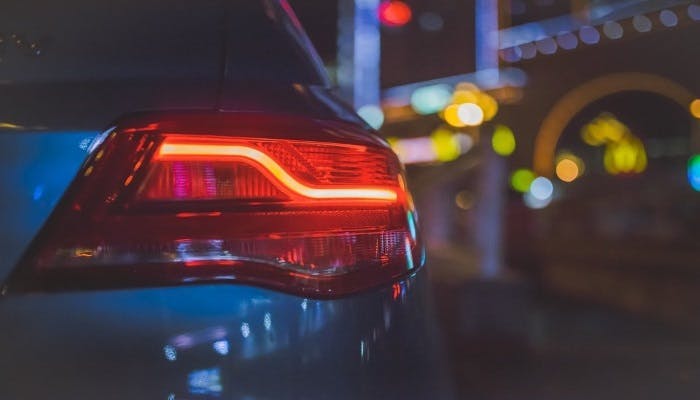
The driving test comes with a wide range of twists and turns for even the most prepared of learner drivers—from the dreaded manoeuvres to the 'show me, tell me' questions. Another, oftentimes forgotten, part of the test that unnerves learner drivers is the emergency stop. With 1 in 3 learners having to demonstrate one on their test, it's pretty important that you know how to do it right. So, if you haven't yet gotten to grips with the emergency stop procedure, we're here to set you on the right path!
In this guide, we're going to walk you through everything you need to know about the emergency stop: how to perform it safely, what the examiner will be keeping an eye out for and when you might need to use it in real-life conditions.

What is the emergency stop?
The clue is in the name here—the emergency stop is testing a driver's ability to stop the car quickly, without losing control or skidding, in the event of an emergency. In an ideal world, you would never even need to carry out an emergency stop. With your well-developed hazard perception skills and knowledge of the Highway Code, you should be able to predict any issues on the road and be able to avoid them using defensive driving techniques and the like. Of course, if something was to happen that you didn't see coming, an emergency stop could be a literal lifesaver.
When you're taking your driving test, there's a 1-in-3 chance that you'll be asked to complete an emergency stop. If you end up having to demonstrate an emergency stop, the examiner will tell you to pull up on the left beforehand and give you verbal instructions along these lines:
“In a short time, I will ask you to carry out an emergency stop. I will do so by giving the signal, “stop”, and raising my hand. When I do, I'd like you to stop as quickly and as safely as possible. Don't worry about looking around, I will make sure it's safe before asking you to do so. Do you understand these instructions?”
Please note:
The examiner is required to make sure road and traffic conditions are suitable for the emergency stop procedure—so you don't have to worry about observations. Just carry out the procedure as quickly and as safely as you can.
If a natural emergency stop has already occurred during the practical, then the examiner will tell you that you're no longer required to demonstrate an emergency stop—they will include this on your feedback sheet (DL25).
What is the examiner looking for?

The whole point to the emergency stop is that you're able to carry it out hastily yet safely. It's no use coming to a stop in 0.5 seconds if you've just swerved and almost hit the kerb to do it. As such, the examiner will be keeping a close eye out for complete control of the vehicle—you need to keep both hands on the steering wheel. You will also need to carry out the procedure using the clutch and brake correctly. The examiner will be keeping a close eye out for observations one the procedure is complete, just before the learner sets off again.
Throughout the manoeuvre, the examiner will be keeping an eye out for:
- Speed. You will have already had prior warning that the procedure is impending, and you'll also be told that the examiner will carry out observations and checks to ensure it is safe. As such, it's up to you to act quickly and decisively as soon as you get the verbal and visual cues.
- Control of the vehicle. Using the clutch and brake pedals correctly, you will need to maintain full control of the vehicle as you bring it to a stop. Any swerving, screeching or coasting may result in you picking up minor (or major) faults.
- Checks and observations. Once you've completed the procedure, you'll be expected to complete full all-around checks to ensure it is safe and clear for you to move off and rejoin traffic.
You could pick up driving test faults during this procedure for: coasting, not stopping quickly enough, skidding or overall lack of control of the vehicle.
Step-by-step: How do I complete an emergency stop?

1. Await instructions
Unlike any of the manoeuvres you might be asked to demonstrate during your driving test, you'll actually get some prior warning for the emergency stop. The examiner does this to ensure you understand what will be expected of you during the emergency stop and so that you're not too blindsided when they ask.
- The examiner will ask you to pull up on the left. Once you've found a safe place, put the handbrake on and select neutral. Then, you'll need to pay close attention to their instructions.
- They will then inform you that in a short while, they will instruct you to carry out an emergency stop. The examiner will carefully show you how they will do this—using a verbal cue, “stop”, and a visual one with their hand raised up.
- You don't have to worry about observations. The examiner is required to check that it's safe for you to carry out the emergency stop procedure, so they'll carry out all the standard observations beforehand.
- Once you've set off again, try not to worry about when the examiner might ask you to carry out the emergency stop—you don't want to be too tense whilst driving! Just relax and drive on as normal.
2. Take action immediately
Though you might have noticed the examiner carrying out various checks, it's important that you wait for their signal to start the emergency stop. If you stop the car accidentally—misinterpreting a signal or making the assumption that the examiner was going to ask you—you could end up failing your driving test.
- Once the examiner gives you the signal, then you need to take action immediately. Again, there's no need to check your mirrors—the examiner will make sure the roads are clear.
- If your car has an Anti-lock Braking System (ABS), you will need to depress the clutch and brake pedals at the same time for an emergency stop. If your car doesn't have an ABS, you will need to brake and then depress the clutch at the very last moment before you stop—do it too early and you run the risk of coasting.
- Keep both hands on the steering wheel throughout the procedure. Control is absolutely vital with the emergency stop, so you need to make sure you're not swerving. If you end up stalling, don't worry—it's not an automatic fail. Simply restart the car.
- Once the car has come to a stop, apply the handbrake and then select the neutral gear.
3. Observations and move off
After you've stopped the car, the most difficult part of the emergency stop procedure is finally out of the way. Don't celebrate too soon—it's important that you don't let yourself become complacent. The driving test isn't over until you're back at the test centre!
- With the emergency stop over, the examiner will tell you that you can move off when you're ready. Before you start moving, however, you will need to make sure that it's safe to do so.
- It's time for your mirror and blindspot checks. You should work in an anti-clockwise movement—look over your right shoulder blindspot, right-hand mirror, interior, left-hand mirror, left shoulder blindspot and, finally, the rear window.
- Once you're absolutely sure the roads are clear of oncoming traffic, and you don't have any surprise road users in your blindspots, you can start to move.
- Simply select the first gear, release your handbrake, signal your intention to move off, and off you go!
And there you have it! You now know how you might carry out an emergency stop if you're asked to do so on your driving test.
When would this be used in real-life?
When it comes to driving, it's absolutely vital that we take measures to avoid casualties and accidents on the road. From the moment we start learning to drive, we're already pushed to develop our hazard perception skills with the theory test. We then put these skills into practise during our driving lessons, and then, once we've passed, in everyday driving. Unfortunately, no matter how great your hazard perception skills are, or how great a driver you might be, there's no telling what might happen on the roads.
If you're happily driving along your merry way, only for the car in front of you to stop suddenly, or a pedestrian runs out in front of you, you'd have no choice but to stop as quickly and as safely as possible. If the hazard is too close to your car for you to come to a slow stop, then an emergency stop would be your best bet. In short, the emergency stop is your safety net—a precautionary method to ensure you're able to keep yourself and other road users safe in the worst case scenario.
Emergency Stop FAQs
Do I need to signal during an emergency stop?
No. Let's face it, in a real-life emergency, you wouldn't have any time to signal or warn other drivers. Don't preoccupy yourself with your indicators—keep both of your hands on the wheel, as you'll need to stay in complete control. The only time in which you might need to indicate is when you're moving off after carrying out the emergency stop procedure.
When will it happen?
Whilst there isn't a set speed, emergency stops are typically conducted on roads with a speed limit of 30mph. Be aware, however, that there's nothing stopping an examiner from conducting it on roads with a higher speed if the conditions allow it. Of course, you can rule out roads that suffer from heavy traffic and congestion.
What do I do if my car has ABS?
If your car has an Anti-lock Braking System (ABS), then you'll need to depress the clutch and brake pedals at the same time in order to carry out an emergency stop.
What do I do if my car doesn't have ABS?
If your car doesn't have an Anti-lock Braking System (ABS), then you'll need to press the brake pedal and only depress the clutch in the very last moment before you come to a stop. If you press the clutch pedal too soon, then you'll end up coasting and losing control of the vehicle.
How do I know if my car has an ABS or not?
If you're taking the driving test in your instructor's car, then they'll have already told you whether or not it has an ABS. Obviously, if you're not sure, it's important that you ask your instructor. If you're taking the practical in your own car, then you should check your vehicle's manual.
Should I complete observations beforehand?
No, there is absolutely no need for you to complete observations before you carry out the emergency stop. Examiners are required to carry out all-around checks to make sure that it is perfectly safe to carry out the exercise—so, it's their job, not yours.
What are the odds that I'll be asked to do this on my practical?
You have a 1-in-3 chance of being asked to carry out an emergency stop. There's no way of predicting whether you'll be the candidate asked to do so, so there's no point in trying to avoid it. Instead, make sure you know how to carry out the emergency stop procedure safely—you never know when you might need it.
Will I fail if I stall the car whilst carrying out an emergency stop?
Not necessarily. It all depends on how you act in the aftermath and whether you retain control of the vehicle. If you panic and lose all sense, the examiner will probably give you a serious driving fault. If, on the other hand, you restart the vehicle and get yourself back to where you were before you stalled, you should be let off with nothing more than a minor.
Subscribe for driving advice, offers & more
We'd love to let you know about our courses, news and offers via email. You may unsubscribe at any time.
Star Genie Limited trading as PassMeFast. Company number 10093359
Copyright © 2024 owned by Star Genie Limited
PassMeFast, Blue Tower, MediaCityUK, Salford, M50 2ST

